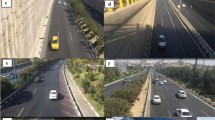Abstract
Undoubtedly, driver performance is one of the most important contributing factors to road safety. A great portion of crashes occurs because of drivers’ misperception of road characteristics, particularly on mountainous two-lane rural roads which consist of many curves. Among the most hazardous road segments are combined horizontal and crest vertical curves which have complicated geometric features and insufficient sight distance. This study aims at investigating driver performance on combined horizontal and crest vertical curves under free flow traffic and head-on traffic conditions. In addition, three new treatments are applied to the same curves in order to compare driver performance with/without treatments and under free flow traffic and head-on traffic. The three treatments include a combination of chevron signs with the herringbones, sealed shoulder and a yellow blinking signal which is a new treatment for warning of on-coming vehicles. Fifteen kilometers of “Karaj–Chalus” two-lane rural road in Iran was replicated in a driving simulator, and the treatments and on-coming traffic were applied to some combined curves of it. Driver performance measures consisting of mean of acceleration and steering wheel angle were obtained from the simulator, and statistical tests were performed. Results indicated that combining chevrons and a warning signal resulted in lower acceleration and steering wheel angle while sealed shoulder reduced neither acceleration nor steering wheel angle. Using herring bones was found to increase only steering wheel angle. Therefore, warning signal application is suggested as the most appropriate treatment for horizontal and crest vertical curves to be applied before combined crest curves.








Similar content being viewed by others
References
Auberlet J et al (2009) The impact of perceptual treatments on lateral control: a study using fixed-base and motion-base driving simulators. Accid Anal Prev 42(1):166–173
Bella F (2014) Driver perception hypothesis: driving simulator study. Transp Res F Traffic Psychol Behav 24:183–196
Charlton SG (2006) The role of attention in horizontal curves: a comparison of advance warning, delineation, and road marking treatments. Accid Anal Prev 39(5):873–885
Charlton SG (2007) The role of attention in horizontal curves: a comparison of advance warning, delineation, and road marking treatments. Accid Anal Prev 39(5):873–885
DoT US (2009) Manual on uniform traffic control devices (MUTCD). Federal Highway Administration, Washington, DC
Farmer ChM, Lund AdrianK (2002) Rollover risk of cars and light trucks after accounting for driver and environmental factors. Accid Anal Prev 34(2):163–173
Forensic Medicine Organization (F.M.O.I.) (2016) Statistical data, accidents [data file]. Tehran, Iran
Hassan Y, Easa SM (2003) Effect of vertical alignment on driver perception of horizontal curves. J Transp Eng 129(4):399–407
Johnston IR (1982) Modifying driver behaviour on rural road curves-a review of recent research. No. V11, Pt4
Jørgensen F, Wentzel-Larsen T (1999) Optimal use of warning signs in traffic. Accid Anal Prev 31(6):729.31–738.31
Kanellaidis G (1995) Factors affecting drivers’ choice of speed on roadway curves. J Saf Res 26(1):49–56
Kashani AT, Anvari MB, Mohammadian A (2016a) Male drivers speed choice in Iran in relation to driver and front passenger characteristics. Transp Res F Traffic Psychol Behav 41:97–103
Kashani AT, Ayazi E, Ravasani MS (2016b) Identifying significant variables influencing overtaking maneuvers on two-lane, two-way rural roads in Iran. Period Polytech Transp Eng 44(3):155–163
Kazemzadehazad S, Monajjem S, Larue G (2018) Driving simulator validation for speed research on curves of two-lane rural roads. In: Proceedings of the institution of civil engineers—transport (getting accepted)
Mohaymany AS, Kashani AT, Shahri M (2015) Evaluation of overtaking manoeuvres on two-lane rural roads. In: Proceedings of the Institution of Civil Engineers-Transport, 168, No. 6. Thomas Telford Ltd, pp 523–531
Organization for Economic Co-operation and Development (1999) OECD principles of corporate governance. OECD, 1999.18
Räsänen M (2005) Effects of a rumble strip barrier line on lane keeping in a curve. Accid Anal Prev 37(3):575–581
Rosey Fl, Auberlet JM (2014) Driving simulator configuration impacts drivers’ behavior and control performance: an example with studies of a rural intersection. Transp Res F Traffic Psychol Behav 27:99–111
Rosey Fl et al (2008) Impact of perceptual treatments on lateral control during driving on crest vertical curves: a driving simulator study. Accid Anal Prev 40(4):1513–1523
Samer H, Qin L, Talebpour A (2016) Weather and road geometry impact on longitudinal driving behavior: exploratory analysis using an empirically supported acceleration modeling framework. Transp Res C Emerg Technol 67:193–213
Van Der Horst R, De Ridder S (2007) Influence of roadside infrastructure on driving behavior: driving simulator study. Transp Res Rec 2018(1):36–44
Zhao X et al (2014) The effect of chevron alignment signs on driver performance on horizontal curves with different roadway geometries. Accid Anal Prev 75:226–235
Author information
Authors and Affiliations
Corresponding author
Rights and permissions
About this article
Cite this article
Monajjem, S., Kazemzadehazad, S. & Larue, G. The Effect of New Treatments and On-Coming Traffic on Driver Performance on Combined Horizontal and Crest Vertical Curves of Two-Lane Rural Roads: A Driving Simulator Study. Iran J Sci Technol Trans Civ Eng 43, 521–531 (2019). https://doi.org/10.1007/s40996-018-0211-3
Received:
Accepted:
Published:
Issue Date:
DOI: https://doi.org/10.1007/s40996-018-0211-3




